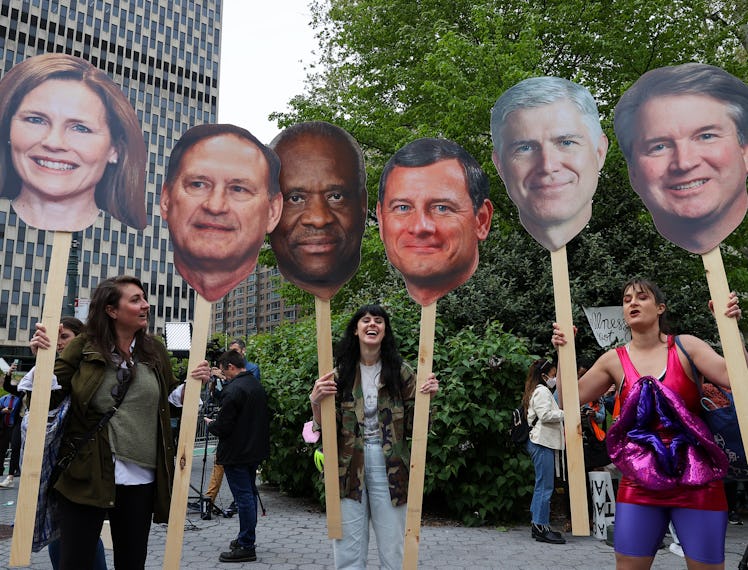What We Know (and Don’t Know) About the Supreme Court’s Roe vs. Wade Leak

In a rare written statement, Supreme Court Chief Justice John Roberts confirmed the authenticity of a document which leaked May 2 that, if issued, would overturn Roe vs. Wade—the landmark 1973 decision, protecting a woman’s right to abortion. Roberts stressed, however, that “it does not represent a decision by the Court or the final position of any member on the issues in the case."
The leak, published last night by Politco, is unprecedented. Even longtime watchers of the notoriously secretive Supreme Court were hesitant to draw concrete conclusions. The leak raised more questions than it directly answered, and it’s important to consider what don’t know as much as what we do.
What We Do Know
The Supreme Court Will Issue a Final Decision on Dobbs vs. Jackson Women’s Health Organization in the Coming Months
The case in question challenges a 2018 Mississippi state law that outlawed almost all abortions after 15 weeks without exceptions for rape or incest. The case directly challenged the Roe vs. Wade decision, as well as the 1992 Planned Parenthood vs. Casey decision.
The case is the first major challenge to Roe since the death of Justice Ruth Bader Ginsburg and her subsequent replacement on the court by Justice Amy Coney Barrett, a Trump appointee. Activists on both sides had anticipated the possibility of a complete overturn of Roe, though many had also anticipated a decision that would leave Roe in place—albeit one that would further chip away at the protections it provided, effectively allowing other states to ban abortions after 15 weeks without outlawing them completely.
The final decision is expected to be released by July.
The Leak Was a First Draft Rarely Seen by the Public
According to Politico, the draft was written by conservative Justice Samuel Alito, and is consistent with his impassioned and often caustic writing style (Alito has, at times, delivered fiery political speeches in private settings, an uncommon move for Supreme Court Justices). The draft was written as a majority opinion after five justices had privately voted to effectively overturn Roe. But Politico notes that such drafts would generally undergo numerous revisions after being circulated among other justices, and that votes can and often do change during the process. The originals are never released to the public.
Overturning Roe Would Not Outlaw Abortion Nationwide, But Would Have Immediate Consequences
As Alito’s own draft states, the decision would immediately return all regulation of abortion back to the states. In anticipation of the decision, state lawmakers on both sides have already began to prepare for that possibility.
Many states with Democratic majorities have or are currently working on laws that would codify abortion rights into state law—and in some cases, state constitutions. A federal Supreme Court decision would also not overrule state supreme courts that have previously ruled a right to abortion exists in its state constitution (such as in Florida, despite the fact its state government is currently Republican-controlled).
However, some states controlled by Republican lawmakers have already passed “trigger laws” that would either outlaw or greatly restrict abortion laws if Roe vs. Wade was overturned. Some states would also have to deal with older abortions laws that are still technically on the books, but were invalidated by Roe and never repealed.
The Center for Reproductive Rights has a map illustrating what could happen in each state.
Both Sides are Also Preparing for the Possibility of Federal Legislation
In March, the Democrat-backed Women’s Health Protection Act failed to pass the Senate. Still, Democrats have renewed calls to pass legislation that codifies a right to abortion in federal law.
Meanwhile, some Republicans already support a federal “Heartbeat Bill” that would ban abortion nationwide after six weeks.
The Supreme Court Is Mindful of Its Own Reputation and Legitimacy
Although this issue weighs on the minds of some justices more than others, the modern Supreme Court has a tendency to be cautious when it comes to perceptions of its own legitimacy. That means since the draft was written, there’s likely been just as much discussion about the merits of the actual case at hand and the legitimacy of the Roe decision as how a decision to overturn might be perceived. In a land where 70 percent of the public supports keeping Roe in place, many Justices could be worried that overturning so quickly after Donald Trump had appointed three justices would be seen as pointedly political and delegitimizing.
What We Don’t Know
Why It Was Leaked
Politico has been cautious about protecting its source, and included no direct context about how the document was obtained or why it was leaked.
How the Justices Will Actually Vote
Some have surmised that the court has not yet finalized its decision, hence the timing of the leak. But without the full context, we can’t assume as much.
What You Can Do
Donate to Local Abortion Funds
Although you can continue to donate to Planned Parenthood and NARAL-Pro-Choice, many activists are encouraging donations to local groups in the states most likely to be directly and immediately affected should Roe be overturned. AbortionFunds.org provides a handy resource.